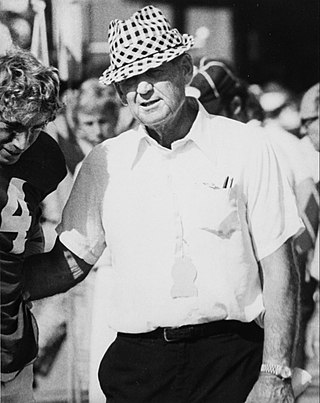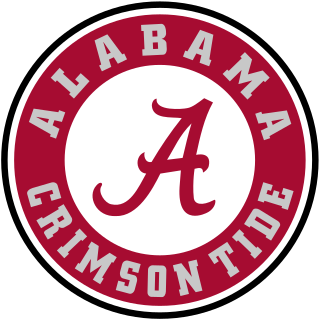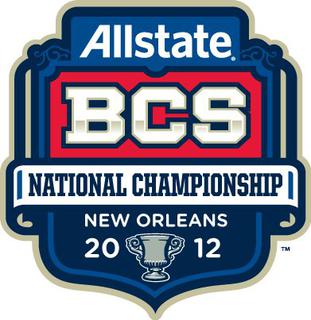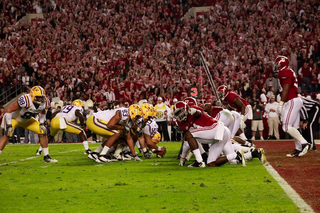
The Cotton Bowl Classic is an American college football bowl game that has been held annually in the Dallas–Fort Worth metroplex since January 1, 1937. The game was originally played at its namesake stadium in Dallas before moving to Cowboys Stadium in nearby Arlington in 2010. Since 2014, the game has been sponsored by the Goodyear Tire and Rubber Company and officially known as the Goodyear Cotton Bowl Classic; it was previously sponsored by Mobil (1989–1995) and Southwestern Bell Corporation/SBC Communications/AT&T (1997–2014).

Paul William "Bear" Bryant was an American college football player and coach. He is considered by many to be one of the greatest college football coaches of all time, and best known as the head coach of the University of Alabama football team from 1958 to 1982. During his 25-year tenure as Alabama's head coach, he amassed six national championships and thirteen conference championships. Upon his retirement in 1982, he held the record for the most wins (323) as a head coach in collegiate football history. The Paul W. Bryant Museum, Paul W. Bryant Hall, Paul W. Bryant Drive, and Bryant–Denny Stadium are all named in his honor at the University of Alabama. He was also known for his trademark black and white houndstooth hat, even though he normally wore a plaid one, deep voice, casually leaning up against the goal post during pre-game warmups, and holding his rolled-up game plan while on the sidelines. Before arriving at Alabama, Bryant was head football coach at the University of Maryland, the University of Kentucky, and Texas A&M University.

Nicholas Lou Saban Jr. is an American football coach. He has served as the head football coach at the University of Alabama since 2007. He is widely considered one of the greatest college football coaches of all time. Saban previously served as head coach of the National Football League (NFL)'s Miami Dolphins and at three other universities: Louisiana State University (LSU), Michigan State University, and the University of Toledo.
Mike Shula is an American football coach who is the senior offensive assistant for the Buffalo Bills of the National Football League (NFL). A graduate of the University of Alabama, he was the school's head football coach from 2003 to 2006. He was the offensive coordinator for the Tampa Bay Buccaneers from 1996 to 1999, the Carolina Panthers from 2013 to 2017, and the New York Giants from 2018 to 2019.

The Alabama Crimson Tide football program represents the University of Alabama in the sport of American football. The team competes in the Football Bowl Subdivision (FBS) of the National Collegiate Athletic Association (NCAA) and the Western Division of the Southeastern Conference (SEC). The team's head coach is Nick Saban, who has led the Tide to six national championships over his tenure. The Crimson Tide is among the most storied and decorated football programs in NCAA history. Since beginning play in 1892, the program claims 18 national championships, including 13 wire-service national titles in the poll-era, and five other titles before the poll-era. From 1958 to 1982, the team was led by Hall of Fame coach Paul "Bear" Bryant, who won six national titles with the program. It was not until 2009 that an Alabama player received a Heisman Trophy, when running back Mark Ingram II became the university's first winner. In 2015, Derrick Henry became the university's second Heisman winner. The Crimson Tide won back to back Heisman trophies in 2020 and 2021, with DeVonta Smith and Bryce Young.

The 2010 Citi BCS National Championship Game was a college football bowl game to determine the national champion of the 2009 NCAA Division I FBS football season, and was played between the Texas Longhorns and the Alabama Crimson Tide. It was hosted by the Pasadena Tournament of Roses Association at the Rose Bowl Stadium in Pasadena, California, January 7, 2010. It was the 12th BCS National Championship Game, and the second consecutive year the champion of the Southeastern Conference (SEC) was matched against the champion of the Big 12 Conference. Alabama got the win over Texas, 37-21, to complete a perfect 14-0 season and clinch the school's 13th national championship.

The 2006 Alabama Crimson Tide football team represented the University of Alabama for the 2006 NCAA Division I FBS football season. The Tide was led by head coach Mike Shula entering his fourth year at Alabama. Despite a strong 5–2 start, they finished out the season by losing four of their final five games. The team closed the regular season at 6–6 and lost for a fifth-straight time to rival Auburn. Following the loss Shula was fired as head coach and defensive coordinator Joe Kines served as interim head coach for the bowl game.

The 2008 Alabama Crimson Tide football team represented the University of Alabama in the 2008 NCAA Division I FBS football season. It was the Crimson Tide's 114th overall season, 75th season as a member of the Southeastern Conference (SEC) and its 17th within the SEC Western Division. The team was led by head coach Nick Saban, in his second year, and played their home games at Bryant–Denny Stadium in Tuscaloosa, Alabama.
The 2003 Alabama Crimson Tide football team represented the University of Alabama in the 2003 NCAA Division I-A football season. It was the Crimson Tide's 69th as a member of the Southeastern Conference (SEC) and its 12th within the SEC Western Division. The team was led by head coach Mike Shula, in his first year, and played their home games at Legion Field in Birmingham and Bryant–Denny Stadium in Tuscaloosa, Alabama. They finished the season with a record of four wins and nine losses.
The 1964 Sugar Bowl was the thirtieth edition of the college football bowl game, played at Tulane Stadium in New Orleans, Louisiana, on Wednesday, January 1. Part of the 1963–64 bowl game season, it matched the seventh-ranked Ole Miss Rebels and the #8 Alabama Crimson Tide, both of the Southeastern Conference (SEC), although the two teams had not met in years.
The 1980 Sugar Bowl was the 46th edition of the college football bowl game, played at the Louisiana Superdome in New Orleans, Louisiana, on Tuesday, January 1. Part of the 1979–80 bowl game season, it matched the undefeated and second-ranked Alabama Crimson Tide of the Southeastern Conference (SEC) and the #6 Arkansas Razorbacks of the Southwest Conference (SWC). Favored Alabama won 24–9, and gained their third national championship of the decade.
The 1960 Alabama Crimson Tide football team represented the University of Alabama in the 1960 NCAA University Division football season. It was the Crimson Tide's 66th overall and 27th season as a member of the Southeastern Conference (SEC). The team was led by head coach Bear Bryant, in his third year, and played their home games at Denny Stadium in Tuscaloosa and Legion Field in Birmingham, Alabama. They finished with a record of eight wins, one loss and two ties and with a tie against Texas in the Bluebonnet Bowl.

The 2012 Allstate BCS National Championship Game was a postseason college football bowl game between the Alabama Crimson Tide and the LSU Tigers, and determined the national champion of the 2011 NCAA Division I FBS football season on Monday, January 9, 2012, at the Mercedes-Benz Superdome in New Orleans, Louisiana. The game was part of the 2011–2012 Bowl Championship Series and a rematch of regular season foes. Alabama beat LSU 21–0 to win their 14th national championship, marking the first shutout in a national championship game since the 1992 Orange Bowl and the first ever shutout in a BCS bowl game. The game had the third-lowest TV rating, 14.01, in the 14-year history of the BCS National Championship game.

The 2011 Alabama Crimson Tide football team represented the University of Alabama in the 2011 NCAA Division I FBS football season. It was the Crimson Tide's 117th overall and 78th season as a member of the Southeastern Conference (SEC) and its 20th within the SEC Western Division. The team was led by head coach Nick Saban, in his fifth year, and played their home games at Bryant–Denny Stadium in Tuscaloosa, Alabama. They finished the season with a record of twelve wins and one loss and as consensus national champions.

The 1942 Cotton Bowl Classic, part of the 1941 bowl game season, took place on January 1, 1942, at the Cotton Bowl in Dallas, Texas. The competing teams were the Alabama Crimson Tide, representing the Southeastern Conference (SEC), and the Texas A&M Aggies, representing the Southwest Conference (SWC) as conference champions. Alabama won the game 29–21.
The 1945 Sugar Bowl, part of the 1944 bowl game season, took place on January 1, 1945, at Tulane Stadium in New Orleans, Louisiana. The competing teams were the Alabama Crimson Tide, representing the Southeastern Conference (SEC) and the Duke Blue Devils, representing the Southern Conference (SoCon). Duke won the game 29–26.

The 2011 LSU vs. Alabama football game was a regular-season college football game between the unbeaten LSU Tigers, and the unbeaten Alabama Crimson Tide on November 5, 2011, at Bryant–Denny Stadium in Tuscaloosa, Alabama. Coined a "Game of the Century," this was the first time two Southeastern Conference (SEC) football teams came into a regular season matchup undefeated and ranked No. 1 and No. 2 in the nation. In a game dominated by defense and special teams, LSU won in overtime 9–6. LSU kicker Drew Alleman made all 3 of his field goals, while Alabama kickers Jeremy Shelley and Cade Foster made only 2 out of their 6 attempts, proving to be decisive in the game.
Alabama Crimson Tide football under Nick Saban covers the history of the Alabama Crimson Tide football program since Nick Saban was hired as head coach in 2007. Alabama plays as part of the National Collegiate Athletic Association (NCAA) Football Bowl Subdivision (FBS) and is a member of the West Division of the Southeastern Conference (SEC). The Tide plays its home games at Bryant–Denny Stadium in Tuscaloosa, Alabama. Their overall official record under Saban is 201–28 (.878), 23 bowl game appearances with 16 victories, ten SEC West titles, nine SEC championships, and six national championships. Since 2008, Saban's teams have spent part or all of each season ranked at least top 4 in national polls.
The Alabama Crimson Tide football team represents the University of Alabama in American football.









